- Clone
- MJ7/18 (See other available formats)
- Regulatory Status
- RUO
- Other Names
- Endoglin
- Isotype
- Rat IgG2a, κ
- Ave. Rating
- Submit a Review
- Product Citations
- publications
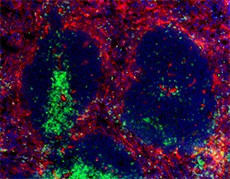
-

C57BL/6 mouse frozen spleen section was fixed with 4% paraformaldehyde (PFA) for ten minutes at room temperature and blocked with 5% FBS for 30 minutes at room temperature. Then the section was stained with 10 µg/ml of purified anti-mouse CD105 (clone MJ7/18) and 10 µg/ml of Alexa Fluor® 647 anti-mouse CD3ε (clone 145-2C11) (green) overnight at 4°C, followed by 2.5 µg/ml of Alexa Fluor® 594 Goat anti-rat IgG (clone Poly4054) (red) for two hours at room temperature. Nuclei were counterstained with DAPI (blue). The image was captured with a 10X objective. -

C57BL/6 mouse frozen liver section was fixed with 4% paraformaldehyde (PFA) for ten minutes at room temperature and blocked with 5% FBS for 30 minutes at room temperature. Then the section was stained with 10 µg/ml of purified anti-mouse CD105 (clone MJ7/18) overnight at 4°C, followed by 2.5 µg/ml of Alexa Fluor® 594 Goat anti-rat IgG (clone Poly4054) (red) for two hours at room temperature. Nuclei were counterstained with DAPI (blue). The image was captured with a 10X objective.
| Cat # | Size | Price | Quantity Check Availability | Save | ||
|---|---|---|---|---|---|---|
| 120401 | 50 µg | 57€ | ||||
| 120402 | 500 µg | 207€ | ||||
CD105 is a 90 kD homodimeric type I integral membrane glycoprotein, also known as endoglin. It is expressed on endothelial cells (especially on angiogenic endothelial cells) and upregulated by hypoxia, activated monocytes, macrophages, bone marrow stromal cells, and some cytotrophoblasts. CD105 is a receptor for TGF-β1, TGF-β3 and modulates TGF-β signaling by interacting with TGF-β receptors I and/or II. CD105 also binds other growth factors such as actvin A, BMP-2, and BMP-7. CD105 has been show to be a useful marker for identifying proliferating endothelium involved in tumor angiogenesis and can be used for tumor imaging and prognosis, and has therapeutic potential for some solid tumors and other angiogenic diseases.
Product DetailsProduct Details
- Verified Reactivity
- Mouse
- Antibody Type
- Monoclonal
- Host Species
- Rat
- Immunogen
- Inflamed mouse skin
- Formulation
- Phosphate-buffered solution, pH 7.2, containing 0.09% sodium azide.
- Preparation
- The antibody was purified by affinity chromatography.
- Concentration
- 0.5 mg/ml
- Storage & Handling
- The antibody solution should be stored undiluted between 2°C and 8°C.
- Application
-
FC - Quality tested
IHC-F - Verified
WB, IP - Reported in the literature, not verified in house - Recommended Usage
-
Each lot of this antibody is quality control tested by immunofluorescent staining with flow cytometric analysis. For flow cytometric staining, the suggested use of this reagent is ≤0.25 µg per million cells in 100 µl volume. For immunohistochemical staining on frozen tissue sections, the suggested use of this reagent is 5.0-10 µg per ml. It is recommended that the reagent be titrated for optimal performance for each application.
- Application Notes
-
Additional reported applications include: immunoprecipitation, Western blotting, and immunofluorescence histochemistry or immunohistochemistry of acetone-fixed frozen sections2-4.
- Application References
-
- Ge AZ and Butcher EC. 1994. Gene 138:201.
- Baluk P, et al. 2003. Am. J. Pathol. 163:1801. (IHC)
- Takahashi T, et al. 2003. Mol. Cell Biol. 23:1817. (IHC)
- Savinov AY, et al. 2003. J. Exp. Med. 197:643. (IHC)
- Product Citations
-
- RRID
-
AB_961066 (BioLegend Cat. No. 120401)
AB_961070 (BioLegend Cat. No. 120402)
Antigen Details
- Structure
- Type I integral membrane protein, homodimer, TGF-β type III receptor family member
- Distribution
-
Endothelial cells, activated monocytes, macrophages, stromal cells, some cytotrophoblast
- Function
- Suppresses TGF-β signaling, angiogenesis
- Ligand/Receptor
- TGF-β1, TGF-β3
- Cell Type
- Endothelial cells, Macrophages, Mesenchymal Stem Cells, Monocytes
- Biology Area
- Angiogenesis, Cell Adhesion, Cell Biology, Immunology, Stem Cells
- Molecular Family
- Adhesion Molecules, CD Molecules
- Antigen References
-
1. Gougos A and M. Letarte 1988. J. Immunol. 141:1925.
2. Cheifetz S, et al. 1992. J. Bio. Chem. 267:19027.
3. Barbara NP, et al. 1999. J. Bio. Chem. 274:584.
4. Lastres P, et al. 1992. Eur. J. Immunol. 22:393.
5. Duff S, et al. 2003. FASEB J. 17:984.
6. Warrington K, et al. 2005. Anticancer Res. 25:185. - Gene ID
- 13805 View all products for this Gene ID
- UniProt
- View information about CD105 on UniProt.org
Other Formats
View All CD105 Reagents Request Custom Conjugation| Description | Clone | Applications |
|---|---|---|
| Purified anti-mouse CD105 | MJ7/18 | FC,IHC-F,WB,IP |
| Biotin anti-mouse CD105 | MJ7/18 | FC |
| Alexa Fluor® 488 anti-mouse CD105 | MJ7/18 | FC |
| PE anti-mouse CD105 | MJ7/18 | FC |
| PE/Cyanine7 anti-mouse CD105 | MJ7/18 | FC |
| Pacific Blue™ anti-mouse CD105 | MJ7/18 | FC |
| APC anti-mouse CD105 | MJ7/18 | FC |
| PerCP/Cyanine5.5 anti-mouse CD105 | MJ7/18 | FC |
| Alexa Fluor® 594 anti-mouse CD105 | MJ7/18 | IHC-F |
| Alexa Fluor® 647 anti-mouse CD105 | MJ7/18 | IHC-F |
| TotalSeq™-A0812 anti-mouse CD105 | MJ7/18 | PG |
| PE/Dazzle™ 594 anti-mouse CD105 | MJ7/18 | FC |
| APC/Fire™ 750 anti-mouse CD105 | MJ7/18 | FC |
| PE/Cyanine5 anti-mouse CD105 | MJ7/18 | FC |
| TotalSeq™-C0812 anti-mouse CD105 | MJ7/18 | PG |
| APC/Cyanine7 anti-mouse CD105 | MJ7/18 | FC |
| TotalSeq™-B0812 anti-mouse CD105 | MJ7/18 | PG |
| Brilliant Violet 421™ anti-mouse CD105 | MJ7/18 | FC |
| Brilliant Violet 785™ anti-mouse CD105 | MJ7/18 | FC |
Customers Also Purchased
Compare Data Across All Formats
This data display is provided for general comparisons between formats.
Your actual data may vary due to variations in samples, target cells, instruments and their settings, staining conditions, and other factors.
If you need assistance with selecting the best format contact our expert technical support team.
-
Purified anti-mouse CD105
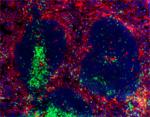
C57BL/6 mouse frozen spleen section was fixed with 4% parafo... 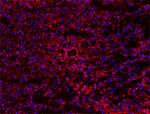
C57BL/6 mouse frozen liver section was fixed with 4% parafor... -
Biotin anti-mouse CD105
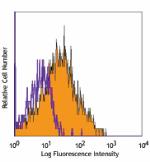
BEND.3, mouse endothelial cells stained with MJ7/18 biotin, ... -
Alexa Fluor® 488 anti-mouse CD105
-
PE anti-mouse CD105
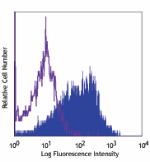
BEND.3, mouse endothelial cells stained with MJ7/18 PE -
PE/Cyanine7 anti-mouse CD105
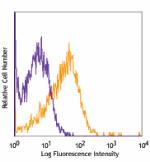
BEND.3 mouse endothelial cells stained with MJ7/18 PE/Cyanin... -
Pacific Blue™ anti-mouse CD105
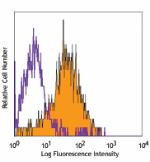
bEND.3 cells stained with MJ7/18 Pacific Blue™ -
APC anti-mouse CD105
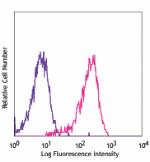
Mouse endothelial cell line bEnd.3 stained with MJ7/18 APC -
PerCP/Cyanine5.5 anti-mouse CD105
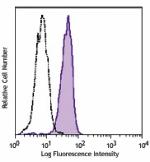
Mouse endothelial cells bEnd.3 were stained with CD105 (clon... -
Alexa Fluor® 594 anti-mouse CD105
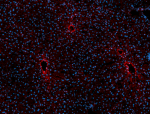
C57BL/6 mouse frozen liver section was fixed with 4% parafor... -
Alexa Fluor® 647 anti-mouse CD105
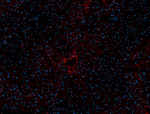
C57BL/6 mouse frozen liver section was fixed with 4% parafor... -
TotalSeq™-A0812 anti-mouse CD105
-
PE/Dazzle™ 594 anti-mouse CD105
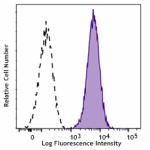
BEND.3 mouse endothelial cells stained with CD105 (clone MJ7... -
APC/Fire™ 750 anti-mouse CD105
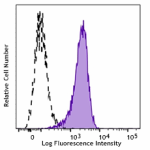
BEND.3 mouse endothelial cells stained with CD105 (clone MJ7... -
PE/Cyanine5 anti-mouse CD105
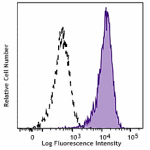
BEND.3 mouse endothelial cells stained with CD105 (clone MJ7... -
TotalSeq™-C0812 anti-mouse CD105
-
APC/Cyanine7 anti-mouse CD105
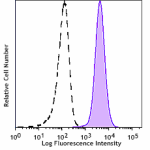
BEND.3 mouse endothelial cells were stained with anti-mouse ... -
TotalSeq™-B0812 anti-mouse CD105
-
Brilliant Violet 421™ anti-mouse CD105
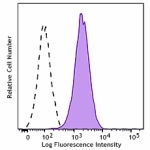
Mouse endothelial cells bEnd.3 were stained with anti-mouse ... -
Brilliant Violet 785™ anti-mouse CD105
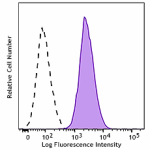
Mouse endothelial cells bEnd.3 were stained with anti-mouse ...
 Login / Register
Login / Register 





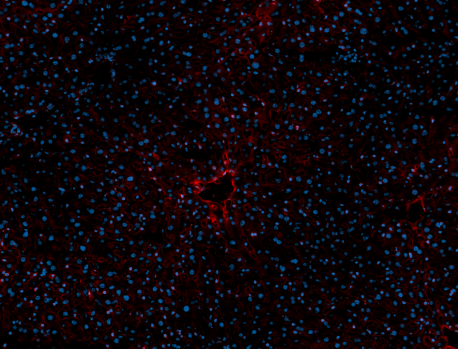
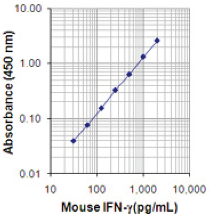
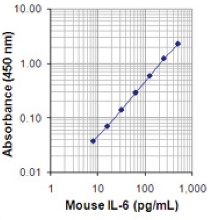
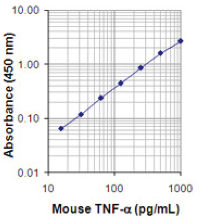



Follow Us